Best road bike pedals 2025: our complete guide to the best clipless pedal systems
Improving your pedalling efficiency, power transfer, and comfort, the best pedals for road bikes can be one of the most cost-effective upgrades you can make
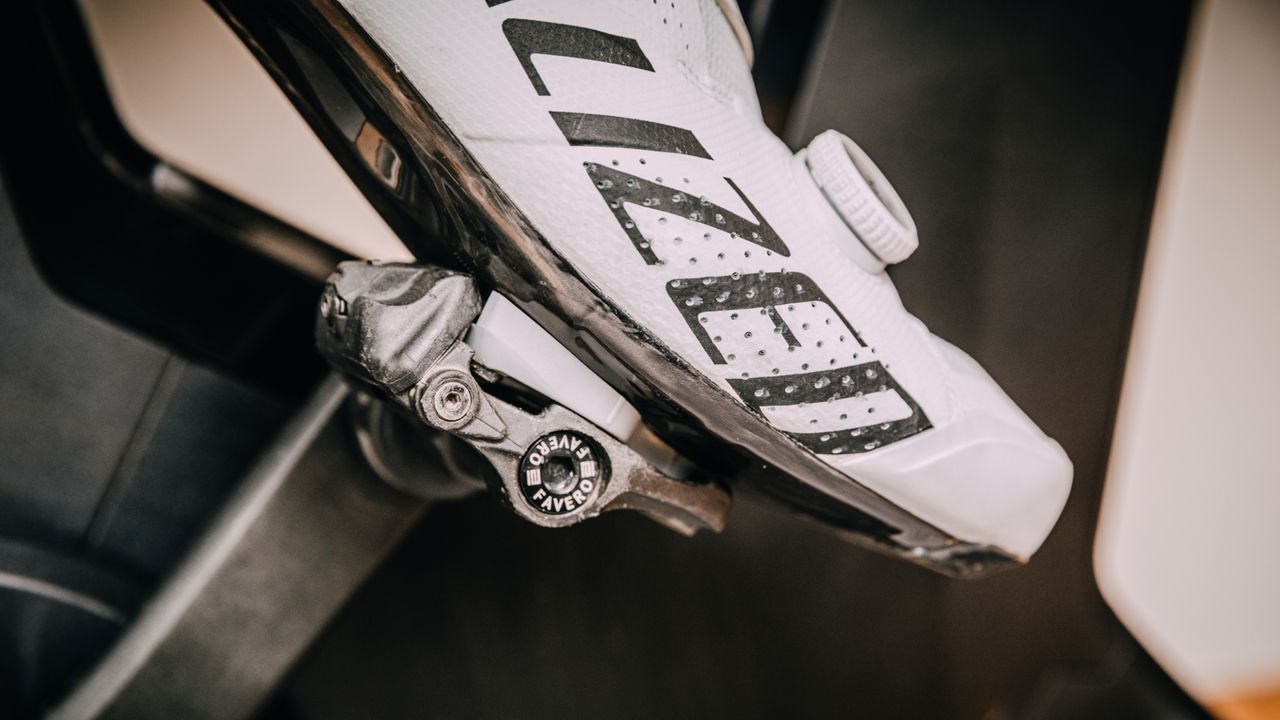
A set of the best road bike pedals and a pair of the best cycling shoes will set you up for miles of happy cycling. The benefits of using these over the best flat pedals in terms of comfort and efficiency are considerable, but there is a learning curve to using the best clipless pedals.
This guide focuses on the best clipless pedals for road bikes. These pedals are also known as SPD SL, Keo, or three-bolt cleat systems, but they are most commonly characterised as single-entry pedals and designed for use with the best road bikes. Many may be familiar with the alternative, the two-bolt SPD cleat system popularised by Shimano. Recently adopted for gravel riding, this system is commonly used by mountain bikers. Why not look at our guide to the best gravel bike pedals? and work out what might suit you the best; there is nothing stopping you from using either.
Every road bike pedal in this guide has been ridden, tested and assessed by our experienced riders in a range of conditions to give a score out of 5. While many pedal manufacturers are in the market, the two leading features heavily in this guide take the top two spots. Our best overall, the Shimano 105 PD-R7000, offers the best all-around value and brings that Shimano quality and performance to the masses. If you want to move over to the best clipless pedals, you should consider our best budget, the Look Keo Classics. The entry price point into the Keo cleat system offers surprisingly good performance and ease of use for those new to cleats.
If you are already a seasoned clipless pedal rider looking to take your riding to the next level, you should check out our guide to the best power meter pedals.
The quick list
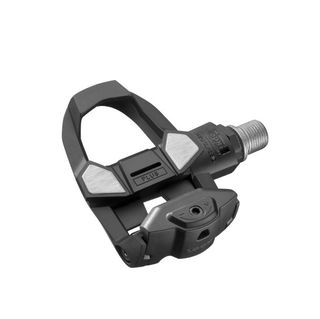
A good entry-level choice, the Look Keo Classic pedals use a coil spring tension adjustment and a plastic composite body with a wide contact area for pedalling stability.
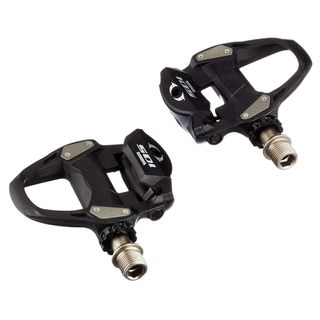
The PD-R7000s are everything you need. These 105-level pedals offer positive engagement and release, decent adjustability, and float, all for just 50g/1.7 oz more than the Ultegra alternative.
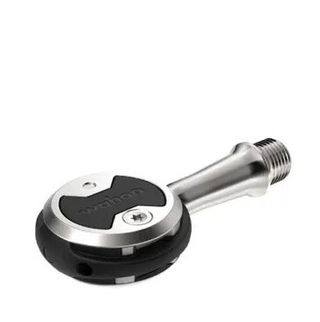
Speedplay pedals give you wide float and release angle adjustability, making them ideal for perfecting fit. The Zeros have multiple spindle lengths for further fine-tuning fit and efficiency.
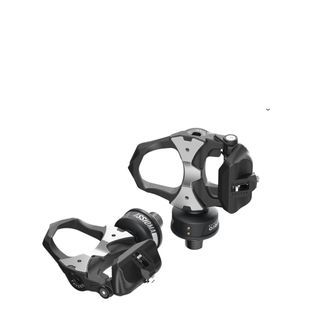
Favero's power meter is accurate, and in addition to the usual stats, it also measures time spent seated vs. standing and how centred your pedalling is on the platform.
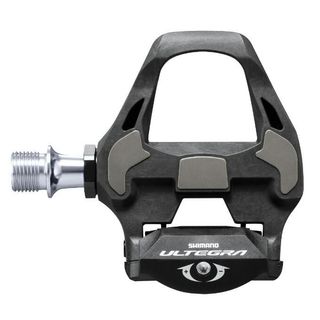
Can I be bold enough to say that the R8000s are an affordable Dura-Ace pedal? With little weight difference between these and the R9100s, which only sport a slightly larger bearing, the R8000s are a bit of a no-brainer.
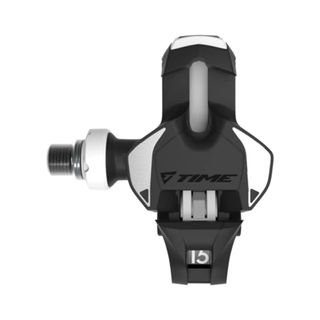
Pedals as light as the Time XPRO 15's come at a cost, but with that cost as comes a serious levels of performance. So, yes the XPRO's are nearly the cost of some power pedals but its not all about the low weight.
The best road bikes pedals: our top-rated picks
Best budget pedals
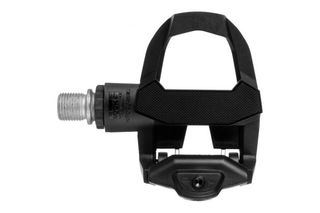
Keo Classic 3
Specifications
Reasons to buy
Reasons to avoid
These are great starter clipless pedals and ideal for winter miles when it's not worth bringing out the more expensive sets.
Trading the carbon blade of the higher-end Look pedals for a coil spring-based mechanism makes for easy release tension adjustment, almost mirroring the Shimano versions.
A good-sized contact patch for your foot provides a stable pedaling platform, and one that we found still offers enough power transfer to be a viable option for strong riders putting out high wattage.
The composite material does add weight to the scales but doesn't detract from their performance, with the Look trademark and highly regarded standard still on board, making these a pair of the best clipless pedals on the market.
A suitably priced and easy option for beginners to take their first steps into the world of clipless pedals.
Read more: Look Keo Classic 3 pedals full review
Best all-round
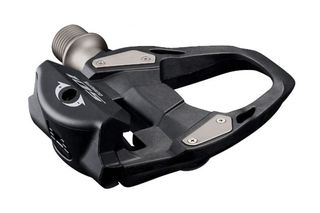
Shimano 105 SPD
Specifications
Reasons to buy
Reasons to avoid
Shimano's 105 PD-R7000 pedals are nearly identical to their Ultegra and Dura-Ace counterparts, the main difference being the pedal body is carbon reinforced instead of carbon fibre.
This does of course add a little weight to the pedals, around 50g per side, but when you calculate the cost saving per gram (especially if you can pick these up in a deal) then the weight penalty suddenly seems much less.
From our experience, these are great clipless pedals for riders looking for quality and durability without breaking the bank, especially when you’ve just splashed out on a new set of cycling shoes. We liked the positive engagement and release of the 105s.
As with the Shimano Dura-Ace and Look Pedal ranges, the spring tension is adjustable via an Allen key, which can take a couple of rides to get just right for your needs, so worth taking one in the back pocket for the first few outings.
The other similarity with the other pairs of the best clipless pedals mentioned above is that the 'float' is limited by the cleats, which isn't really a drawback, just be aware and always worth getting a professional bike fitter to help set up your shoes to ensure you get the right pair for you.
As with other Shimano pedals, the cleats are probably the widest on the market, which can make them visible on either side of your cycling shoes, and although they are one of the most robust on the market, they aren't designed for walking far in.
Read more: Shimano 105 pedals full review
Most adjustable
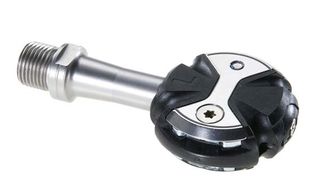
Wahoo Speedplay Zero
Specifications
Reasons to buy
Reasons to avoid
Wahoo has given the Speedplay Zero pedals a much-needed update, while still preserving all the benefits of the original. You still get all the float adjustability, dual-sided entry, low weight, and interchangeable axle lengths, but now the weather protection has been greatly increased and the stainless steel bevelled edge improves durability of the pedal body.
On test, we were very impressed with their performance and certainly found them to be one of the best clipless pedals on the market, with the float being easy to adjust and feeling particularly friction-free.
As one of the smallest pedal platforms available, the Wahoo Speedplay Zero pedals might look alarming to some of the more powerful riders, concerned that their lollipop looks might limit power transfer. We found that it was in fact of no concern, the cleat design provides all the strength and secure connection needed. In fact, according to Wahoo, once you factor in their lower stack height, which places your foot closer to the pedal axle, you can actually recruit more power than other setups.
The initial setup of the larger-than-standard cleat is a bit more of a process, especially when compared to the almost plug-and-play functionality of the Shimano and Look pedals, so we definitely recommend investing in the skills of a professional bike fitter. Once dialled in, however, you'll be sure to reap all the benefits.
Read more: Wahoo Speedplay Zero pedals full review
Best power meter pedals
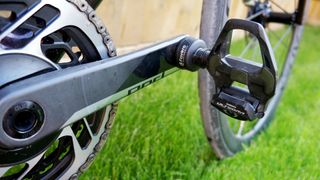
Favero Assioma
Specifications
Reasons to buy
Reasons to avoid
The Favero Assioma pedal power meter undercuts the main competition. We've reviewed the Duo two-sided Look cleat-compatible meter, but there's also a single-sided option, the Uno.
We also have a first-ride review of the Favero Assioma Duo Shi power meter. Favero sells the power meter spindle, but you need to mount your own Shimano pedal bodies to these, so it's not a complete solution out of the box and the 65mm Q-Factor is significantly wider than the more standard 54mm of the Look version.
The Favero Assioma power meter pedals are lighter than the competition and include a rechargeable battery with a claimed 50-hour battery life, which uses a magnetic charging clip.
Accuracy is claimed at +/-1% and data is transmitted to your head unit via both ANT+ and BLE. There's also more analysis built-in than with some other power meters, including seated vs out-of-saddle riding and where on the pedal body your power delivery is centered, as well as the usual (with dual-sided meters) left-right balance.
The only downside we noted was the awkward pedal weighting due to the power meter pods wrapped around the axle, which could make clipping in difficult.
Read more: Favero Assioma Duo power meter review
Best Performance pedals
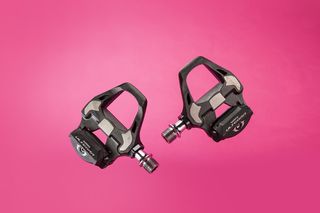
Shimano Ultegra SPD
Specifications
Reasons to buy
Reasons to avoid
Shimano's Ultegra pedals won a place in our Editor's Choice awards, impressing us with a low stack height, wide platform and a design not far off that of the top-end Dura-Ace models - all at a lower price.
These are great quality pedals that are incredibly durable, going for thousands of miles between servicing.
All Shimano pedals use the same spring retention system that requires a 2.5mm Allen key to adjust. It can take a little time to get just right, so it's worth taking the right size key with you on the first few rides but we have never had an issue when trying to adjust these to our liking.
Again like all Shimano pedals, and Look ones for that matter, Ultegra pedals gain the pedal float from the cleat, with different colored 'tips' on the cleats denoting the amount of movement side to side they will allow before unclipping. They’re available with 6° (with yellow tips), 2° (blue) or zero float (red), depending on your preference (it's always recommended to start with more if you're not sure).
We love that it is super easy to take them apart and regrease the axle. It's also worth noting that there is a 4mm longer axle available too should you need a wider Q factor - something only offered with Ultegra and Dura-Ace.
The RRP is more expensive than the Shimano 105 option, but you can find some great deals if you shop around.
Read more: Shimano Ultegra pedals full review
Best lightweight pedals
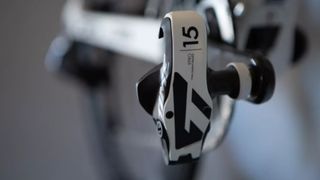
Time Xpro 15
Specifications
Reasons to buy
Reasons to avoid
There's no denying the jaw-dropping retail price of the Time Xpro 15 pedals, especially when compared to the more wallet-friendly Xpresso range with the Time Xpresso 6 pedals, which, although somewhat dated, we also really liked.
On test, we found it tricky to pinpoint one specific character trait, rather it was an amalgamation of several features that make these one of the best clipless pedals on the market.
To start there's the exceptionally secure carbon leaf spring system. Their featherweight design, 87g a piece, makes them one of the lightest clipless pedal systems on the market, without sacrificing the platform size, which is slightly wider than traditional Time pedals. We found engagement positive and secure, whilst in use there were no noticeable pressure points or any other issues.
For riders looking for the best, then the carbon outer, hollow titanium spindle and ceramic bearings will be music to their ears. However, the meagre 2.5mm of lateral side-to-side float might not be enough for your knee's requirements, especially as they don't allow for alterations to cleat release tension; this requires fitting a different leaf spring. This didn't trouble us, but other pedal manufacturers offer significantly more float.
As with all Time pedals, they offer an alternative to the major players, such as Look and Shimano, although clearly comparable to the range-topping Shimano Dura-Ace and Look Keo Blade Carbon Ceramic versions.
But to stand out from the crowd, you'll have to pay for the privilege, with these being one of the most expensive pairs of clipless pedals on the market.
Read more: Time Xpro 15 pedals full review
Most secure
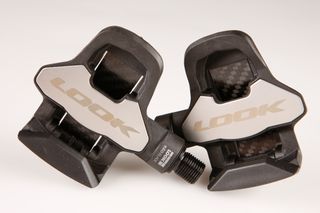
Look Keo Blades
Specifications
Reasons to buy
Reasons to avoid
There are several different versions of the Look pedal systems (the Keo Classic is featured above) and these top the family tree as the best clipless pedals for anyone looking for a performance pair.
Look say that the ceramic bearing version reduces friction by 18% and helps increase power transfer, although this is not something we can personally confirm.
Look uses a carbon leaf spring in place of the more common metal spring, like the Shimano Ultegra pedals above, for cleat retention, cutting the weight and providing a satisfying tactile snap when you clip in.
This does mean you don’t get the same instant range of adjustment as you get with a spring system, but you can get the leaf spring in a range of different strengths to make clipping out easier or harder.
From our experience, this does mean deciding on what tension suits you best is tricky, and a little fiddly, so you might be inclined to enlist support from your local bike shop/ bike fitter to sort - but once you’ve got it set up you won’t need to touch it again.
As per all Look cleats, they can be quick to wear down though, requiring regular replacement unless you're conscientious enough to use cleat covers when walking around, which often come with your pedals or cleats.
Read more: Look Keo Blade pedals full review
Honourable mention - Shimano PD-M520
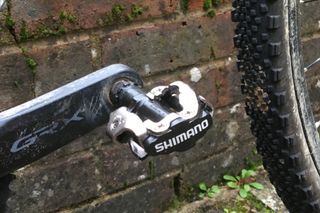
Shimano PD-M520
We understand that the best road bike pedals aren't suitable for everyone for several reasons. Perhaps you use your shoes and pedals across multiple types of bikes, or you're simply not a fan of the 'penguin walk' necessitated by the top road cycling shoes. Of course, other options, such as the best gravel bike pedals, overlap significantly with cyclocross and mountain biking but can also be used for road.
Our top choice for gravel pedals is the unassuming Shimano PD-M520, arguably one of the most reliable pedals ever created. Although they may not be extravagant or particularly lightweight, they perform their function effectively and are likely to outlast several pairs of shoes or even bikes.
Don't let anyone tell you that SPDs can't be used on the best road bikes. They certainly can and provide a much more versatile option. They work brilliantly across multiple bikes, meaning you only have to invest in one pair of shoes. When paired with the best gravel bike shoes, an SPD setup can be an excellent choice for long tours or bikepacking, particularly when stops and exploration on foot are commonplace.
Read our full Shimano PD-M520 SPD pedal review
Advice
What is a clipless pedal?

Specialized road shoes clipped into Favero Assiomas
If you're wondering what exactly is a clipless pedal, then here's a brief explanation.
A clipless pedal is one that you actually do clip into. For most options this requires you to attach a cleat to your cycling shoe, which then clips into a spring-loaded mechanism in the pedal body. To release your foot, you twist it in one direction to release the cleat from the pedal.
The reason they're called clipless is that before Look invented the original clipless pedal, riders would use a toe clip and strap to connect their shoes to the bike - hence as a pedal without such a clip they became known as 'clipless'.
If you are curious as to how to use clipless pedals then you'll be surprised to learn it's much easier than you might think, and once you've converted, you won't be able to imagine doing without.
What are the differences between the best clipless pedals?
There are a handful of pedal systems to choose from which allow you to clip in.
We've included lots of information on the differences, pros and cons below, but as a quick summary, the main differences are around the system being proud or recessed on your shoe.
The former is more road-focused as it creates a bigger platform for power transfer; the Look Keo pedals are a good example. The latter allows for easier walking off the bike and less chance of getting clogged up, with the Shimano SPD system a good example (don't confuse this with Shimano SPD-SL, which is a road-type pedal system).
The adjustability of the pedal system is another big buying factor, with some, like that of Speedplay, allowing for plenty of micro-adjustments, and a favorite with riders who can suffer from knee pain. Other systems will allow for some tension adjustment, but this tends to be limited to spring tension, the ease of clipping in and out, and/or float; the ability to rotate your foot in the pedal without risking unclipping.
Other factors include the size of the platform, closeness to the axle and Q-factor (the distance between your attachment points on the pedals).
Pedal systems: Look Keo
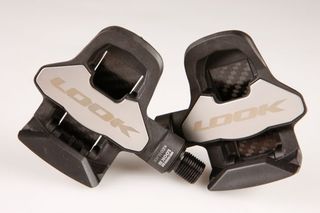
Look Keo
Look pioneered clipless pedals back in the Eighties, and it has maintained a huge presence in the market ever since.
The pedals use a three-bolt design, with a large surface area to the cleat that can make walking a little cumbersome but provides a good contact patch when on the bike.
While some Look pedals use a standard coil spring for cleat retention, the fancy ones utilize a carbon leaf spring. Both are adjustable, allowing you to have your cleats on an easy release if you're nervous or struggle to twist out, or extra tight if you're more confident and going for a sprint or hard climb.
There are several different models in the Look Keo range, and several different cleat options too, making these a really good brand of pedal to grow with as your cycling experience and needs evolve.
The most basic model, the Look Keo Classic 3 is great for getting going on the road, while an all-singing pair of Look Keo Blade Carbon Ceramic Ti pedals will provide the kind of aero and smoothness gains when you are wanting high-end performance.
The only downside is their limitations on rougher terrains, where the system isn't really geared up to dabbing, not getting clogged up, or walking with a non-recessed cleat. There is a Keo Grip cleat option and a cover which makes touring and benign gravel riding doable in them, but you wouldn't want to take them for a long walk or truly off-road for a ride.
That said, if you're sticking to the tarmac, they're some of the best clipless pedals that you can get at whatever level you're looking to take your cycling to.
Good for: Road riding, road racing, time trailing, commuting
Pedal Systems: Shimano SPD double-sided

Shimano SPD double-sided clipless pedals
More commonly used by mountain bikers, gravel grinders and commuters, SPDs have been around for 20 years and they've seen little change since. A range of other brands offer SPD-compatible pedals, not just Shimano.
The twin-sided pedals mean clipping in is easy. The cleat uses a two-bolt system and is recessed into the shoe which allows for easy walking off the bike. Being made of metal and away fro m contact with the ground, the cleats can last for years.
The contact patch is a touch smaller than road specific pedals, but the pedal body is designed to clear mud, making them ideal for mixed surface riding. Combined with the walkability, this also makes them a good choice for commuting and touring when you don't want to take a pair of shoes for off-bike use.
Shimano SPD pedals are also pretty popular in gyms on spin bikes, benefiting the rider from easy clipping in, the gains from pulling up on the pedal, allowing bike-specific shoes, which are stiffer and provide better pedal power transfer, but also safety when walking to and from class.
The downside is that you will need a pair of shoes with just two-bolt holes, and in most cases, the shoes will have more flexibility and the smaller contact point will lose some of the pedal power.
Good for – Gravel, mountain biking, cyclocross, touring, commuting, gym bikes
Pedal systems: Shimano SPD one-sided
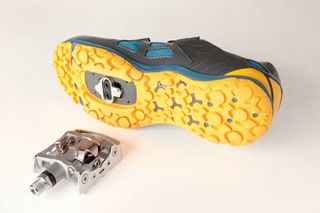
Shimano SPD one-sided pedals
This system combines an SPD clipless mechanism with a flat pedal - which makes it a great clipless pedal option for people who feel nervous about having their feet attached to the bike, or commuters who want to be able to quickly get a foot on the pedal without having to search for the contact or look down. The shape also means you can use them with your regular street shoes, so a great option for a mixed-use bike.
The upside is that you gain many of the positive attributes of the above Shimano SPD pedals, mostly when in muddy/ mixed terrain and when needing to walk around, as the recessed cleat does away with a skiddy small wedge under your feet that the usual road pedals create. Again these are another great option for gym bikes, where you have a mix of riders in either trainers or who want to clip in.
Combing two systems for SPD and flat pedal into one does mean that these pedals are a little heavier than other options, so they're not favored by those after pure performance.
Good for – Leisure riding, off-road, commuting, gym
Pedal systems: Wahoo Speedplay
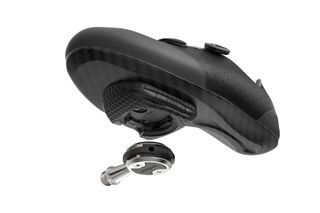
Wahoo Speedplay pedal system
Wahoo Speedplay's 'lollipops' are road-specific pedals that gain the adjustability in their pedaling platform from the cleat, as opposed to the pedal itself. This means the cleat houses all the moving parts and requires the occasional drop of dry lube to keep things running smoothly.
The benefit of Wahoo Speedplay pedals is that they offer a huge amount of adjustability — cleat position is adjustable in three separate planes, and each can be fine-tuned independently of the others. Bike fitters love them, particularly when setting up anyone with knee pain.
The simplicity and double-sided nature also mean they’re easy to get into and they're light, too but the metal cleats can be difficult to walk in and are expensive to replace.
Good for – Road racing (especially criteriums)
Pedal systems: Shimano SPD-SL
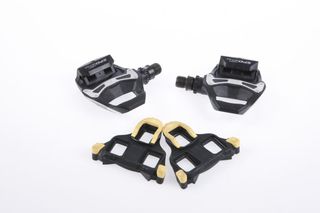
Pedal systems: Shimano SPD SL
Shimano's SPD-SL pedals use a three-bolt cleat system, similar to Look Keo pedals.
The key difference is that the cleats and pedals are broader, creating a wider platform and in theory offering greater power transfer.
Just like the Looks, the cleats come in three different colors, each denoting a different level of float, mirroring the Look cleat system and offering 0°, 2° or 6° of float once clipped in. Again like the Looks, it’s a system that is widely used by the professional peloton.
Just don't expect to walk around on them with ease - and especially not on tiled or polished concrete floors when wet.
There are a few options in the range to choose from, all of which could make the best clipless pedal buying guide. As with all Shimano components, the pedals follow the same naming convention, with Dura-Ace at the top of the family tree, followed by Ultegra and then 105.
The challenge for Shimano is that it makes everything exceptionally well, so the only reason why we've not included the range-topping Dura-Ace pedals is that it's just so hard to justify the extra expense over the significantly more affordable Ultegra and 105 versions.
Good for – Road riding, racing, general riding, commuting
Pedal systems: Time ICLIC pedal systems
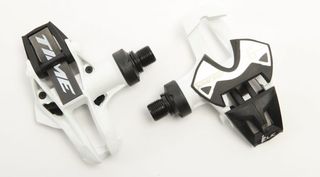
Time pedal systems
While Time ICLIC pedals also use a three-bolt system - you remembered correctly, like Look and Shimano - they work in reverse of most other road pedals.
The carbon leaf spring keeps the mechanism open until you push down, clamping it shut on the cleat with a loud snap — similar to a ski binding.
The cleats are of similar size to Shimano and Look road cleats, so offer a very supportive platform to push on. They’re also quite cheap to replace, which is always a bonus.
The Time ICLIC system boasts lateral (side-to-side) float, and low stack height, is said to increase power transfer efficiency.
Time pedals are pretty niche nowadays, although now part of the wider SRAM operation after Time Bikes sold off its pedal division and we expect to see some exciting development within the pedal brand in the next few years.
Good for – Racing, road riding
Pedal systems: Time ATAC pedal systems
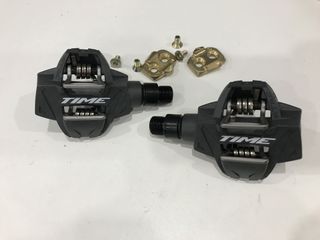
Time ATAC XC 2 pedal
Time's two-bolt ATAC pedal system has a sprung front retainer with a static bar at the rear. This makes for a natural feel to engagement and, as we mentioned above, also helps to clear mud out of the pedal mechanism.
There's quite a range of pedals, with Time offering larger platforms as well as more minimalist designs. Higher up the range, Time offers adjustable release tension, while basic models have a fixed release tension.
You can swap the cleats between the left and right feet to alter the amount of float. There are also multiple cleat options, which again allow you to alter the amount of float and release angle.
Pedal systems: Crankbrothers pedal systems
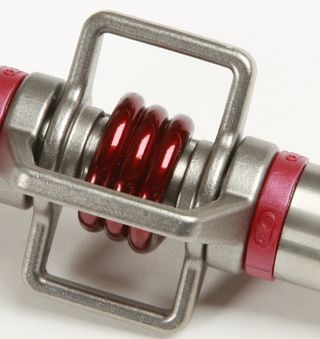
Crankbrothers Eggbeater
The Crankbothers pedal system has a very open design that has little tendency to mud collection. The Eggbeater pedals allow you to clip in on four faces, although the action is slightly different depending on whether the front or rear retainer is sprung.
Crankbrothers' other clipless pedals, the Candy, Mallet and Double Shot, have a larger platform that only allows two-sided use, although the mechanism itself retains the four access options.
The release tension of Crankbrothers pedals is not adjustable, although there are standard and easy release cleat options and both are available with either 6° or 0° of float.
How to fit and remove clipless pedals
Watch this video to learn our mechanic Al’s top tips on clipless pedal installation and removal.
The key thing to remember about pedals is that the left and right ones are threaded differently. The right pedal has a normal thread so that you tighten it by turning the pedal spindle clockwise in the crank arm. The left pedal has a reverse thread so that you tighten it counter-clockwise.
It’s important not to get your left and right pedals mixed up as cross threading a pedal will ruin the pedal and crank. With many clipless pedal systems, such as those from Shimano and Look, it’s pretty obvious which way round they go, as the pedal has a definite front and rear.
But with other systems such as Speedplay, many MTB-type clipless pedals and platform-type pedals it’s harder to work out.
Most will have L or R printed or embossed on the pedal body or the wrench flats on the axle, so it’s worth taking a look before starting to screw them back in. Above all, go carefully and hand-screw the pedal to make sure that it’s threading in correctly, only using a spanner or Allen key once you have it most of the way in.
Although most are easy to set up, what isn't quite as straightforward is how to set them up perfectly for you. We've suggested enlisting the skills of a professional bike fitter throughout this guide to ensure you reap the most rewards and reduce the risk of injury. However if you do want to DIY, then take a look at our guides on Cleats explained: How to set them up correctly and how to set up your cleats (video)
It’s very easy to strip the threads from a crank arm and expensive to replace it if you do, so if you’re not sure the pedal is going in correctly unscrew it and start again. Make sure to add a dollop of grease or anti-seize to the threads to prevent them from getting stuck.
Many pedals will have both Allen key sockets at the end of the spindle and wrench flats where the threads end. Using a pedal wrench will afford much more leverage than most Allen keys.
If you're used to cycling in trainers, or are investing in a new pedal system, the chances are you might need to revisit your saddle height. Our video on how to set your saddle height should give you all the pointers on how to get it just right.
Many pedals such as Shimano Dura-Ace, Ultegra and 105 only have Allen key sockets so if you use these it’s worth getting a chunky 8mm Allen key so that you have enough leverage to loosen the pedal in the crank.
Competitive cyclists now often ride with a power meter and many of the options available are pedal-based. To keep things simple, we've not included many power pedals in this guide, but if you think that's something that might interest you then visit our page on how to ride with a power meter for more information.
The benefit of a pedal power system is its ease of transfer between bikes, although often the pedal needs to be tightened to a specific torque value to obtain accurate readings. This means that you will need a torque wrench – a pricey bit of kit, but fairly insignificant relative to the cost of the power meter itself.
What is the difference between SPD pedals and clipless pedals?
You may have heard fellow cyclists talking about SPD pedals.
SPD stands for 'Shimano Pedaling Dynamics,' and is a clipless pedal system that the Japanese brand created for the mountain bike market. These are still used today and feature a two-bolt cleat system.
However Shimano expanded its SPD clipless line-up to feature SPD-SL, which is designed specifically for road use. The SL stands for 'super light' and uses a three-bolt cleat.
So SPD pedals are clipless and refer to Shimano branded pedals and cleats. However, the term is often used to refer to similar pedal systems from other manufacturers, in the same way that 'Hoover' is used to describe a vacuum cleaner that's made by a rival brand.
What is the difference between clipless and clip pedals?
Clip pedals are essentially flat or cage pedals that are fitted with a toe clip and straps that secure your foot to the pedal.
Clipless pedals, like all those featured in this guide, feature a pedal and cleat system, which allows you to clip into the pedal for improved foot retention and pedaling efficiency.
Flat or 'clip' pedals can be ridden in street shoes, whereas clipless pedals require specific cycling shoes that allow you to attach a cleat to the sole.
How we test
Whether used on or off-road, clipless pedals need to be secure, easy to clip into and transfer the power from legs to bike efficiently. Off-road pedals also need to be durable, robust and still useable in mucky conditions. The Cycling Weekly testers put these pedals through their paces in a wide variety of conditions to evaluate them for these criteria and assess what they each offer to the rider.
Our experience means that you'll have a consistent, in-depth viewpoint, which is reflected in our product scoring. You can find out more on our How We Test page.
Get The Leadout Newsletter
The latest race content, interviews, features, reviews and expert buying guides, direct to your inbox!
Like many, Matt began his bicycle industry journey on the spanners at his local bike shop. After spending his youth mountain biking, he was inspired to embrace gravel during his tenure with Evans Cycles' in-house brands, Pinnacle and Hoy Bikes. Recognising the evolving industry, Matt eagerly seized the chance to become an E-bike designer, winning several awards with the E-bike brand Cairn Cycles.
These days, Matt is likely to have a toddler sitting shotgun or off the beaten track somewhere on the South Downs.
-
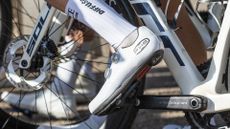 Ekoi releases large platform pedals while Vision goes all-carbon
Ekoi releases large platform pedals while Vision goes all-carbonThe French brand's pedal and shoe combo aim to improve 'efficiency, lightness, aerodynamics, and comfort'.
By Luke Friend Published
-
 Garmin releases new paid-for version of Connect to rival Strava, but promises free version 'is not going away'
Garmin releases new paid-for version of Connect to rival Strava, but promises free version 'is not going away'Tech Giant wants its popular app to be more than just a Strava go-between
By James Shrubsall Published
-
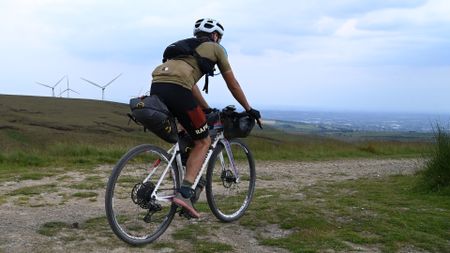 Best cargo bib shorts: extra carrying capacity for your rides
Best cargo bib shorts: extra carrying capacity for your ridesThe best cargo bib shorts will let you stash more items without needing to load up your bike
By Stefan Abram Last updated
-
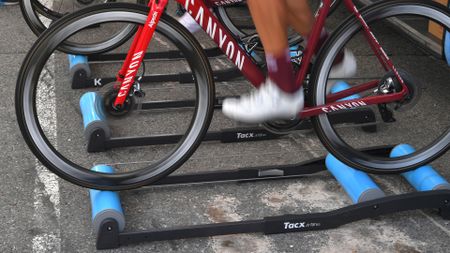 Best bike rollers: add a little spice to your indoor cycling sessions
Best bike rollers: add a little spice to your indoor cycling sessionsHere's our pick of the best bike rollers if you're looking to break up the dreary indoor bike trainer routine with something a little more rocking and rolling
By Michelle Arthurs-Brennan Last updated
-
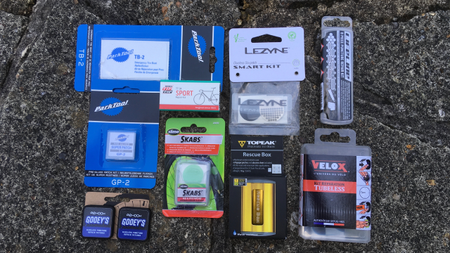 Best puncture repair kits: Don’t waste tubes! Help your wallet and the environment
Best puncture repair kits: Don’t waste tubes! Help your wallet and the environmentGet back on the road as easily as possible with our pick of the best puncture repair kits
By Paul Norman Last updated
-
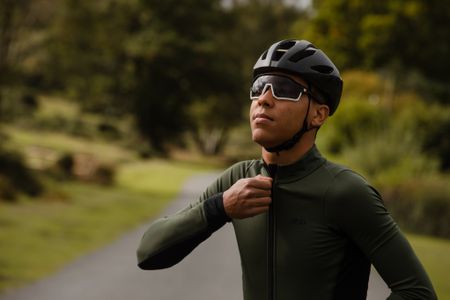 Best cycling jerseys 2025: our favourite jerseys to ride in every season
Best cycling jerseys 2025: our favourite jerseys to ride in every seasonThe best cycling jerseys should keep you comfortable, whether it's hot, cold or even during an indoor session
By Michelle Arthurs-Brennan Last updated
-
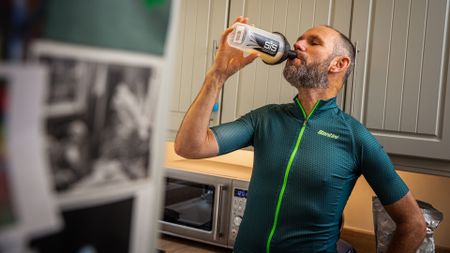 Best recovery drinks for cycling 2025 rated and reviewed
Best recovery drinks for cycling 2025 rated and reviewedWe look at the best available protein and recovery drinks to ensure you’re recovered and good to go for your next training session
By Andy Turner Last updated
-
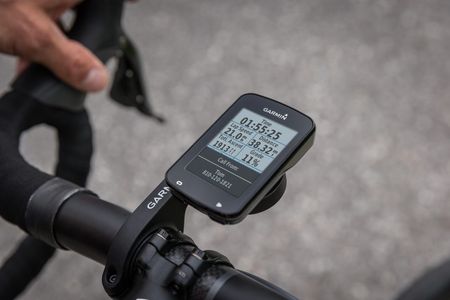 Best Garmin cycling computer: everything you need to know about the range
Best Garmin cycling computer: everything you need to know about the rangeWhether you're looking for a Garmin Edge navigational aid or a computer to push your training, this guide will help you choose the best Garmin Edge for you
By Anna Marie Abram Last updated
-
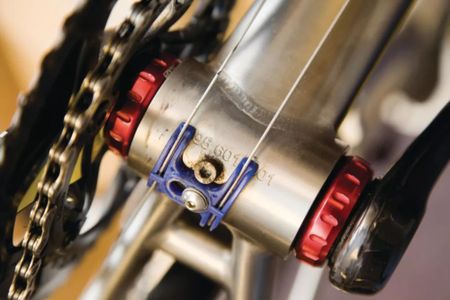 The best bottom bracket for road bikes 2025: stainless steel and ceramic bearing upgrades
The best bottom bracket for road bikes 2025: stainless steel and ceramic bearing upgradesTested and rated aftermarket bottom brackets for staying creak-free and finding extra watts!
By Glen Whittington Last updated
-
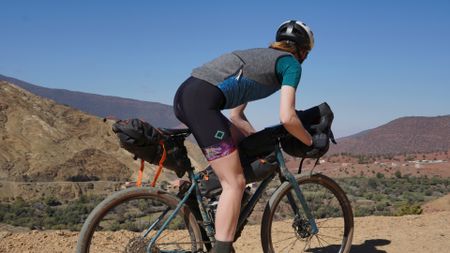 Best bikepacking bags 2023: A buyer's guide for multi-day adventures
Best bikepacking bags 2023: A buyer's guide for multi-day adventuresWe share the best bikepacking bags for multi-day adventures and how to choose the best for you
By Stefan Abram Last updated